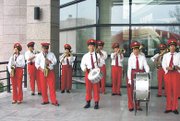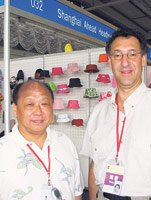Going to the Source
Sourcing trips allow apparel manufacturers to scout factories and make contacts overseas
Last year, Chip Smoler visited China for the first time on an apparel sourcing trip that took more than 85 people to some of the top garment-producing spots in that country.
His goal was simple. He wanted to bypass agents and distributors, the middlemen in most apparel sourcing transactions, and go directly to the clothing factories to structure his own private-label packages for retailers looking for stylishly designed goods at a reasonable price.
He was quite successful. On that first trip, he placed an order for 60,000 pairs of pajamas destined for the store shelves of a Midwestern grocery and general merchandise chain called Meijer.
For Smoler, president of Admar Trading Corp. in Chicago, this was a different way to do business. For years he had hit the major sourcing trade shows in the United States. But he found going to the actual source was much more effective.
“The whole thing is more in-depth, and you get to see the factory,” he said. “You are able to see more of their product, maybe see the first cuts, and start working with them right away.”
Smoler was so successful, he returned on a second trip this May, organized by the same entity, ASAP Show Inc., the El Monte, Calif.–based company run by Frank Yuan. This time, Smoler concentrated on visiting weaving plants and textile factories, which are now working on his ideas for unique fabric selections to incorporate into his own apparel packages. They are working from the same Pantone book, which displays an array of fabric colors.
Trips organized for apparel manufacturers to visit overseas factories is a relatively new business caused by the shift of most of the world’s apparel production to Asia and the disappearance of apparel quotas for the 149 countries that belong to the World Trade Organization. China, however, still has quotas on 34 clothing categories coming into the United States until the end of 2008.
Yuan, born in China but a long-time resident of the United States, was one of the first entrepreneurs to dabble in the idea of taking apparel manufacturers directly to the source.
In 2002, he started organizing sourcing trade shows held at the same time as the giant MAGIC Marketplace in Las Vegas. Twice a year, he would bring in factories from around the world to showcase their businesses in booths set up at the ASAP Global Sourcing Show.
“So many attendees of the sourcing show were saying, ’Frank, it is great to meet these factories here, but we really want to place serious orders, and we need to go there. Why don’t you arrange a trip?’” he remembered.
So in May 2005, he put together an ambitious trip that visited five Chinese cities on a 16-day trip that gave apparel manufacturers ample opportunity to find new factories, as well as get a crash course in Chinese culture and geography.
The first trip was so successful that Yuan organized another trip one year ago to Pakistan and Bangladesh that was productive but had its alarming moments. A car bomb exploded in front of the group’s five-star hotel in Karachi.
Last May, Yuan organized a second trip to China, bringing 75 people to visit Wuxi, Hangzhou and Jinjiang. Later this year, he is organizing another trip to China that will include apparel executives looking for new factories and U.S. companies looking for partners to sell their goods in China.
On the road
Other groups are joining the apparel sourcing trip circuit. In 2004, Apparel magazine, in conjunction with VNU Expositions Asia, started organizing an annual Apparel Sourcing Expo-Asia in Shanghai, where apparel manufacturers can meet more than 300 exhibitors. The two-day event, to be held this year Sept. 19–20, is free to those who register. An additional half-day matchmaking and networking event costs $595. Last year, the expo had 2,079 attendees.
Unlike the trip organized by ASAP Show Inc., Apparel magazine doesn’t make airline and hotel arrangements for attendees. And it isn’t taking people on factory tours this year, said Susan Black, publisher of the magazine, which is based in Columbia, S.C. She noted that people’s interests and needs were so diverse that it was difficult to coordinate apparel factory tours for everyone.
“People were more interested in making their own arrangements,” Black said. “The expo is an efficient way of meeting people.”
That is facilitated by the fact that many factories at the expo are more than happy to arrange tours for apparel manufacturers eager to step on the property and get a close-up look at the operations.
For a while, the American Apparel & Footwear Association, based in Arlington, Va., was organizing trade missions and trips to popular sourcing countries such as India and Vietnam. But the trips have been put on hold due to time and personnel restraints. “There is definitely a demand for it,” said Nate Herman, the association’s international trade advisor.
Indeed, buying trips help manufacturers get a feel for a country’s business climate and its culture. But they don’t always lead to immediate factory orders.
Chuck Martinez, who is part owner of the high-end costume company InCharacter Costumes in San Diego, said he found the pricing on his trip to China last year wasn’t that much better than what he was getting with his Mexican factories in Tijuana, Mexicali and Rosarito, where goods come in dutyfree and quota-free under the North American Free Trade Agreement.
“A lot of the pricing we were getting didn’t knock us out,” he said. “We do finished costumes, and they tend to fall into the highest duty category of 14 to 26 percent. You throw that on top of the freight charges and it really brings the numbers up.”
Martinez and his company continue to do 50 percent of their production in Mexico and the rest in the United States. “We are still trying to figure out our Asia strategy,” he said.
Daniel Sadigh, head of the Los Angeles apparel company Sugar Moods Ltd., ended up using his 2005 trip to China to establish another business that acts as a service center for new and small apparel companies.
His new business is called La Fundamenta. It provides designers, patternmakers, samplemaking services, Web design, computer services, sourcing advice and warehouse facilities.
“I’m taking what I learned from being in China and my experiences as a local manufacturer for over 25 years to create this service center,” Sadigh said. “My intention is to help start-up companies or small manufacturers who don’t have their own facilities so they don’t have to spend a lot of money on overhead and can focus on design and sales.”
Howie Sarmiento, the production sourcing manager for Beniko Inc., the Los Angeles branch of a Canadian company known for its Point Zero label, found his sourcing trip to China last year very interesting. But he didn’t place any orders with Chinese factories because of the unpredictable quota situation for cotton goods. He did, however, meet an Indian apparel manufacturer at one of the sourcing expos organized in Guangzhou, in southern China. He is now a big supplier of men’s woven shirts.
“The trip for me was really more educational,” Sarmiento said. “And I’m still getting a lot of people e-mailing me.”























